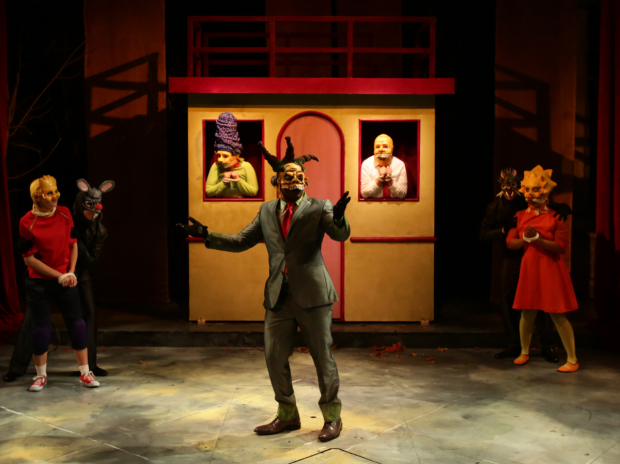Mr. Burns, a Post-Electric Play

(© Mark S. Howard)
It's no wonder that thoughts of an apocalypse linger in our shared consciousness, given the real and present threats of aging nuclear plants, bleached coral reefs, and monster storms (never mind omnipresent terrorist threats). Ever-submerged in our thoughts are questions about what we will do, how we will cope, and who will survive, if the unthinkable happens.
The Lyric Stage realizes Anne Washburn's bleak but imaginative theatrical pastiche about such a world, Mr. Burns, a Post-Electric Play, with A. Nora Long at the helm. In Mr. Burns, Washburn takes our concerns a step further, not only worrying whether civilization will endure, but what will remain of our heritage. In her opinion, architecture, paintings, literature, and symphonies will disappear, and pop culture, the shows we watched together around our television sets, will be all that is left, as if our Bible and our Odyssey.
Mr. Burns is divided into three acts set in different time periods. Act 1 takes place shortly after an undescribed catastrophe that appears to have led to a worldwide nuclear meltdown. Five people gather around a campfire as another one watches from a patch of leafless trees. Rather than thoughts about food or shelter, their animated conversation is centered on the television show The Simpsons. It seems that remembering the details of an episode called "Cape Feare" is the most important thing in their lives. However, danger is never far from their minds. They all carry guns, as well as lithium-powered flashlights, which are the only way to keep darkness at bay now that the electricity is gone.
The second act is set seven years later, when improvised skits about The Simpsons make up the repertory for a touring theatrical troupe. The same characters, now hardened to their new condition, make their living by producing the shows, complete with commercials. The entertainment includes a marvelous send-up of pop songs and club dancing, choreographed by Yo-el Cassell. By Act 3, now 82 years after the catastrophe, the Simpsons episode, combined with the destruction, has been transformed into a sung-through opera, performed by masked characters singing rhymed couplets that end in a glimpse of heaven.
The actors form an ensemble that intertwines in so many ways that it is difficult to single out one of them: the stalwart Joseph Marrella is the pragmatic Matt, turned into the clueless Homer; the innocent but determined Lindsey McWhorter, takes the role of the sensitive young woman, Maria, then becomes the cartoonish Lisa. As both aloof and wary, Brandon G. Green is the gruff Sam, and the villain, Mr. Burns. Chameleon-like, Nael Nacer is first the outlier, next the leading man, and finally Scratchy. The golden-voiced, Aimee Doherty deftly changes from a woman, Quincy, into the rascal, Bart. The ensemble is completed by the Jordan Clark and a Gillian Mackay-Smith in supporting roles.
The marvelous score to the opera has been composed by Michael Fried, with movement throughout directed by Cassell. Long’s assured direction integrates the omnipresent dread into the behavior of the survivors and their descendants through-out the long segue from epoch to epoch. A four-piece orchestra, led by musical director Alyson Jones at the keyboard, accompanies the fully staged third act. The scenic design by Shelley Barish, enhanced by Wen-Ling Liao’s lighting, emphasizes the anti-spectacle effects as if the show were being staged on the same landscape as Beckett’s Waiting for Godot, except for the characters’ masks as the Simpsons (devised by Lauren Duffy).
Washburn's play dwells on a central theme of the creation of stories that are handed down from generation to generation, accruing additional meaning for every age. Washburn leaves us with the comforting notion that even if humanity must perish, creativity will not, and the myths derived from life on earth will continue as long as one person is left to tell the tale.










